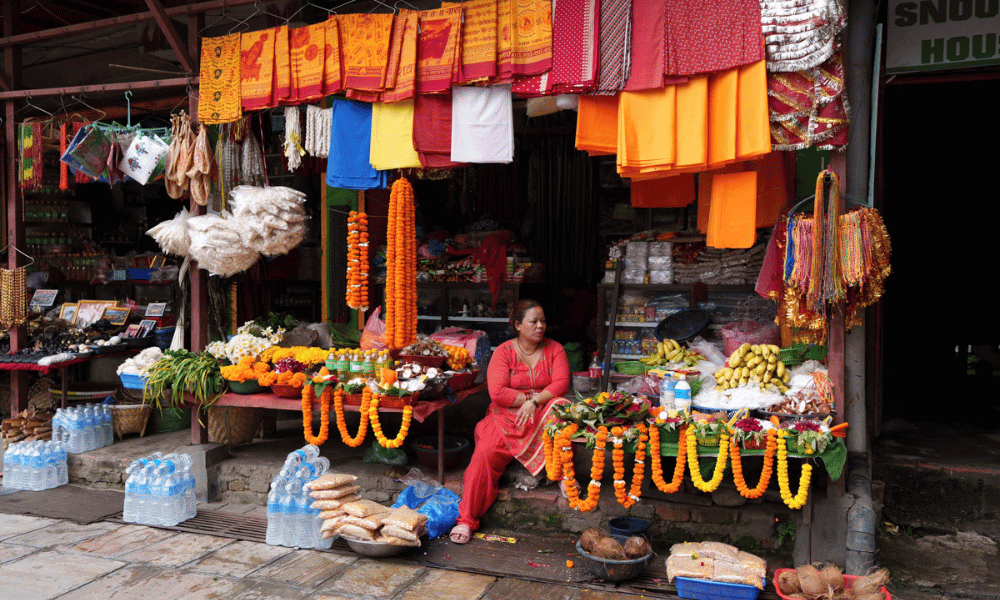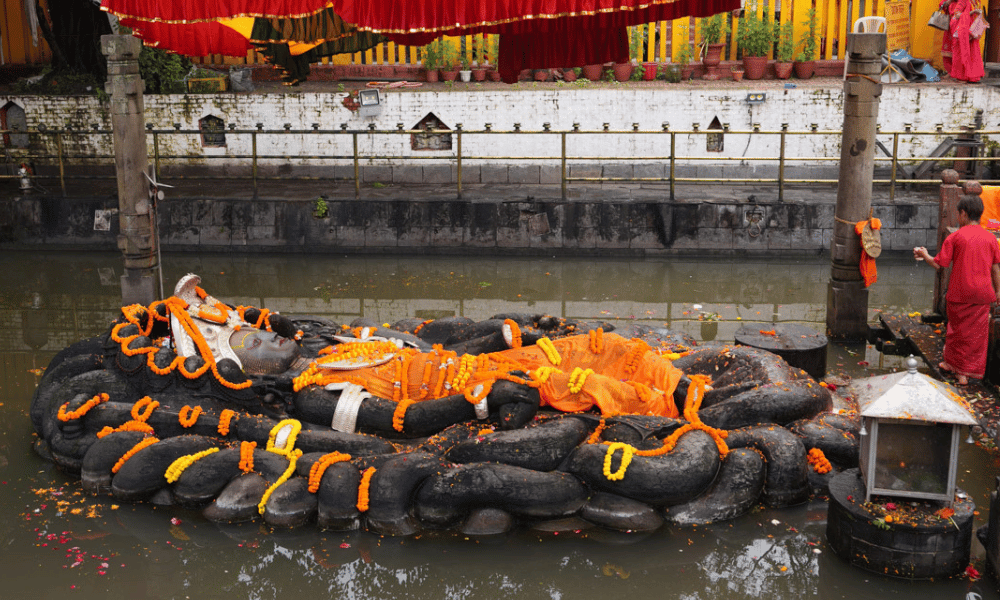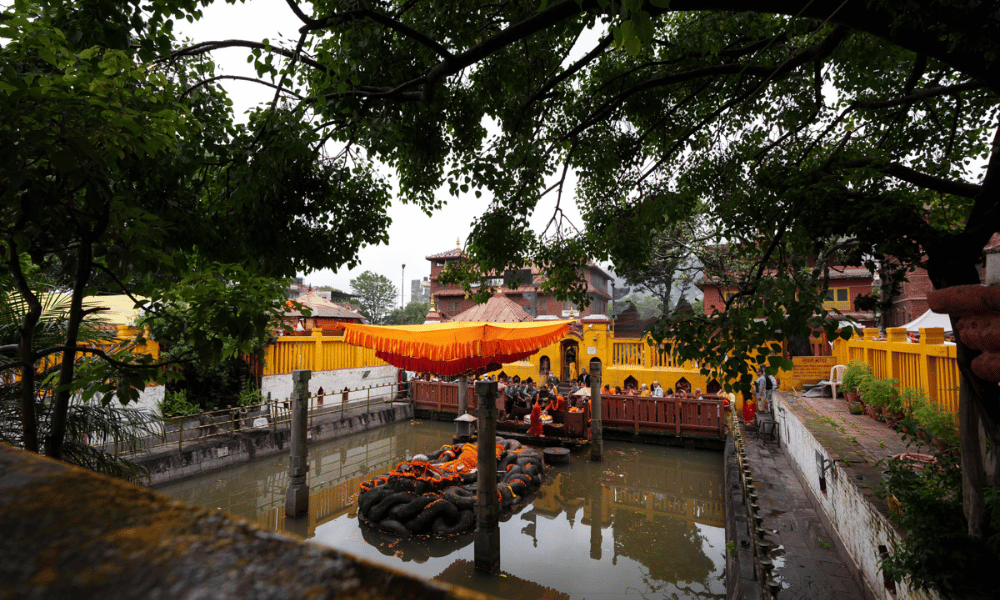The Budhanilkantha Temple also known as Jal Narayan Temple is one of the most holy threads in Nepal's spiritual and cultural tapestry, and it is peacefully nestled away in the center of the Kathmandu Valley. It is believed that the name "Budhanilkantha" comes from the ancient Newari language, where "Budha" means "old", "Nila" means "blue," and "Kantha" means "throat." This ancient temple is full of history, spirituality, and beautiful architecture. This temple, also known as the "Sleeping Vishnu" or "Jalakshetra," is a living witness to the tremendous regard and devotion that have defined Nepal's rich past.
The Budhanilkantha Temple is not just a place of worship; it is also a live archive of spirituality and history. At its heart is a magnificent stone statue of Lord Vishnu, who is the protector in the Hindu trinity. He is reclining gracefully on the coils of the cosmic snake, in the middle of a clear and calm pond. This famous depiction of Lord Vishnu reflects the everlasting harmony between nature and divinity and is both breathtaking and highly significant.
Our trip through the virtual halls of the Budhanilkantha Temple will take us far beyond the stone walls and elaborately carved architecture. We will explore the records of history, describing the origins and evolution of this holy shrine. We will look at the temple's architectural masterpieces, each of which tells a story of craftsmanship and devotion. And, most importantly, we will soak up the spiritual energy that fills the air and learn why this temple is still a spiritual hub for many followers and visitors.
Also Read: Hindu Pilgrimage Sites in Nepal
Budhanilkantha Temple Facts
Here are some facts about Budhanilkanatha Temple:
|
Site |
Budhanilkantha / Jal Narayan |
|
Affiliation |
Hinduism |
|
Deity |
|
|
Location |
Budhanilkantha, Kathmandu |
|
Established by |
N/A |
|
Major Attractions |
|
|
Major Celebrations |
|
|
Style |
Open Air |
|
Opening Hours (main temple) |
04:00 AM - 07:30 PM |
|
Entry Fee |
No Entry Fee |
History and Mythology
Budhanilkantha's history dates back to the 5th century, under the Licchavi dynasty, one of Nepal's first known reigning dynasties. The temple is believed to have been built during the reign of King Vishnu Gupta. However, the origins of the deity's reverence may go back far further in time. The temple's main feature is a magnificent stone figure of Lord Vishnu, standing roughly five meters tall and reclining on a coiled serpent known as Shesha or Ananta. This stunning depiction is carved from a single piece of black stone, displaying exceptional craftsmanship that has stood the test of time.
The temple's name, "Budhanilkantha", is thought to have originated in the ancient Newari language. "Budha" means "old", "Nila" means "blue", and "Kantha" means "throat." The temple's name is derived from a compelling mythology about a farmer discovering an ancient Vishnu idol while plowing his land. This incredible find, the beloved deity in a reclining position, quickly became the object of worship and devotion, leading the construction of the temple. The temple has become a symbol of Nepal's strong religious traditions and cultural legacy over the years.
The history of the Budhanilkantha Temple is interconnected with Nepal's complex socio-religious fabric. Its architectural and visual characteristics testify to the Licchavi period's attentive craftsmanship. The peaceful location of the temple amidst a pond enhances its appeal, providing an ideal environment for spiritual reflection. The temple has been renovated and restored over the years, yet it has preserved its historical and spiritual significance. It is a tribute to Nepal's unwavering commitment to the preservation of its ancient traditions and sacred landmarks, attracting devotees, pilgrims, and curious travelers from all over the world seeking to witness the heavenly grace of the "Sleeping Vishnu".
Related Read: Muktinath Temple
Cultural and Religious Importance
The Budhanilkantha Temple, also known as the "Sleeping Vishnu" Temple, has both cultural and religious significance, tying faith and tradition together in Nepal's spiritual fabric. Architecturally, the temple is a Licchavi dynasty masterpiece, with complex carvings and design elements that serve as a tribute to the nation's artistic past. These architectural features are more than just beautiful; they represent the ability and artistry of old Nepali craftsmen, creating a strong sense of cultural pride in the Nepali people.

The temple is dedicated to Lord Vishnu, a prominent figure in Hinduism, and its centerpiece is a captivating stone statue of the deity reclining. This iconic depiction depicts cosmic harmony and the preservation of the universe, attracting a large number of devotees who come to seek blessings and offer prayers. The serene location of the temple, encircled by a sacred pond thought to have purifying effects, fosters an environment of spiritual reflection and devotion. It also hosts a number of Hindu festivals, stressing its religious significance as a revered place of devotion and cultural celebration. The Budhanilkantha Temple is a living witness to Nepal's spiritual and cultural identity, encapsulating the essence of the country's spiritual and cultural character.
In essence, the Budhanilkantha Temple in Nepal represents a beautiful fusion of culture and faith. Its historical and architectural magnificence reflects Nepal's cultural pride, while its religious holiness reflects its people's everlasting devotion. This one-of-a-kind combination raises the temple to the rank of a cherished and revered landmark, where sacred and cultural tales harmoniously intertwine, enhancing Nepal's spiritual fabric.
Major Attractions of Budhanilkantha Temple
The Budhanilkantha Temple, with its rich cultural and religious significance, offers several major attractions that draw visitors and devotees alike:
The Reclining Vishnu Statue
The Budhanilkantha Temple's reclining Vishnu statue is an appealing and renowned portrayal of Lord Vishnu, one of Hinduism's primary deities. This magnificent monument was carved from a single block of black stone and stands roughly five meters (nearly 16 feet) tall, making it one of Nepal's largest stone sculptures of Lord Vishnu.

Lord Vishnu is depicted in a reclining pose, lying face up on the coils of the cosmic serpent Shesha or Ananta. Lord Vishnu is frequently shown as the "Preserver" in the Hindu trinity (Brahma the Creator, Vishnu the Preserver, and Shiva the Destroyer). This reclining stance represents Lord Vishnu's divine act of preservation, in which he oversees and maintains the universe's order and balance.
The image of Lord Vishnu reclining on the serpent signifies the cosmic ocean, representing the universe' creation and maintenance. Lord Vishnu appears to be in deep sleep in this form, and it is believed that he awakens during times of cosmic crisis to restore balance and safeguard the universe.
The enormous size and artistic precision of this monument often amazes devotees and tourists to the Budhanilkantha Temple. In Hindu philosophy, the picture of Lord Vishnu in this reclining position is not only a focal point for religious rites and offerings, but it is also a symbol of cosmic harmony and the eternal cycle of creation and preservation.
Sacred Pond
A significant and vital part of the temple complex is the sacred pond that surrounds the Budhanilkantha Temple. This serene body of water adds to the spiritual atmosphere of the temple and is important in Hindu ceremonies and traditions.
The water in the sacred pond is said to have divine origins, according to local myths and tales related with the Budhanilkantha Temple. While other variations of the tales exist, the water in the pond is believed to come from an underground stream or spring that flows from Gosaikunda Lake in the Langtang Himalayas.
The pond is more than just a body of water; it represents purity and spirituality. Before entering the temple grounds, devotees and pilgrims typically walk around the pond as a symbol of reverence and purification. Walking around the pond is seen as a religious rite that purifies the soul and prepares individuals for their encounter with the divine. The pure waters of the pond are said to have purifying characteristics, and taking a dip in them is thought to wash away one's sins and impurities.
Major Celebrations in Budhanilkantha Temple
The Budhanilkantha Temple celebrates several Hindu festivals throughout the year, drawing pilgrims and devotees who gather to participate in these religious observances. Some of the major festivals celebrated at the temple include:
Harishayani Ekadashi
Harishayani Ekadashi, also known as Devshayani Ekadashi, is a major Hindu festival celebrated at the Budhanilkantha Temple and other Hindu temples in Nepal and India. It occurs on the eleventh day (Ekadashi) of the bright half of the Hindu lunar month of Ashadh, which corresponds to June or July in the Gregorian calendar. This auspicious day symbolizes the start of Lord Vishnu's cosmic rest, known as the "Chaturmas," which lasts four months.
The title "Harishayani" or "Devshayani" refers to "Lord Vishnu sleeping," and the celebration revolves around the concept that Lord Vishnu enters a state of divine rest during the Chaturmas to escape the summer's blistering heat. Devotees say that on this day, Lord Vishnu reclines on the cosmic serpent Shesha (Ananta) in the same posture as the Budhanilkantha Temple's famed stone statue.
Devotees gather at the temple on Harishayani Ekadashi to offer prayers, perform rituals, and seek Lord Vishnu's blessings. Special ceremonies are held by temple priests to mark Lord Vishnu's rest, and the atmosphere is filled with devotion and spirituality. It is believed that fasting and performing acts of charity on this day can cleanse the soul and bring spiritual merit.
Harishayani Ekadashi marks the start of a sacred season, which is followed by other festivals and religious observances during the Chaturmas, ending in the magnificent celebration of Devuthani Ekadashi, when Lord Vishnu is said to emerge from his glorious sleep. This celebration has enormous cultural and religious significance, forging a strong bond between devotees and the deity at the Budhanilkantha Temple and establishing faith in Lord Vishnu's function as preserver of the universe.
Haribodhini Ekadashi
Haribodhini Ekadashi is a religious festival observed in Nepal at the Budhanilkantha Temple, also known as the "Sleeping Vishnu" Temple. This auspicious Ekadashi occurs on the eleventh day of Kartik, the bright half of the Hindu lunar month, which corresponds to October or November in the Gregorian calendar. It is significant religiously since it symbolizes the end of Lord Vishnu's four-month cosmic rest.
Devotees come together at the temple complex for the Haribodhini Ekadashi festival to celebrate Lord Vishnu's awakening from his divine rest. The main attraction of the festival is the elaborate and ritualistic procession of Lord Vishnu, the temple's principal deity, who is carried in a beautifully adorned palanquin. Devotees chant songs and pray as they accompany the deity in a spectacular procession, creating an energetic and spiritually charged environment.
The celebration also includes religious ceremonies and offerings, as well as traditional musical and dance performances. Devotees come to seek blessings, make offerings, and take part in the festivities, and to express their gratefulness to Lord Vishnu for his protective and sustaining role in the universe. Haribodhini Ekadashi is a time when the Budhanilkantha Temple comes alive with devotion and cultural events, offering a unique view into Nepal's rich religious traditions and Lord Vishnu's enduring worship.
How to reach?
To reach the Budhanilkantha Temple, located in the Kathmandu Valley of Nepal, you can follow these directions:
From Kathmandu City Center:
The temple is situated approximately 8 kilometers north of Kathmandu's city center. You can hire a taxi or take a local bus from various points in Kathmandu, such as Ratna Park or Jamal. Simply tell the driver or conductor that you want to go to "Budhanilkantha," and they will drop you off near the temple.
By Private Vehicle:
If you have your own transportation or have hired a private vehicle, you can navigate using GPS or maps. The temple is well-marked, and you can follow the signs directing you to "Budhanilkantha."
By Public Transport:
From major bus terminals in Kathmandu, such as Ratna Park or Jamal, you can find local buses or microbuses heading to Budhanilkantha. These buses are a budget-friendly option, but they may be crowded.
On Foot:
If you are staying in the nearby areas of Budhanilkantha, you can consider walking to the temple. It's a pleasant walk, and you can enjoy the scenic surroundings along the way.
The Budhanilkantha Temple is a prominent religious site, and locals are usually familiar with its location, so you can also ask for directions if needed. Please note that traffic conditions in Kathmandu can vary, so it's a good idea to check the travel time and routes before setting out, especially during peak hours.
Things To Remember
Before visiting Budhanilkantha Temple, here are some important things to remember:
Modest Attire: Dress conservatively and respectfully. Avoid wearing revealing clothing, and consider covering your shoulders and knees as a sign of respect for the religious site.
Footwear: Remove your shoes before entering the temple premises. There are designated areas for keeping your footwear safe while you explore the temple.
Photography: While photography is generally allowed in the temple complex, it's courteous to seek permission from the authorities before taking photos, especially inside the temple.
Respect Local Customs: Be mindful of the cultural customs and practices. Follow the guidance of temple priests and authorities during rituals and ceremonies.
Silence and Reverence: Maintain a peaceful and quiet demeanor within the temple premises. The temple is a place of worship, and visitors are expected to show reverence.
Offerings: You may choose to make traditional offerings such as flowers, incense, or fruit as a sign of respect to the deity. These offerings can be purchased near the temple.
Temple Timings: Check the temple's opening and closing hours before your visit. Timings may vary, so it's essential to plan your visit accordingly.
Crowds: The temple can get crowded during festivals and peak visiting times. Be prepared for larger crowds and exercise patience.
Environmental Consideration: Respect the natural surroundings and avoid littering. Dispose of trash responsibly and help maintain the temple's serene environment.
Security: Keep an eye on your belongings and valuables to ensure their safety while exploring the temple complex.
By keeping these considerations in mind, you can have a respectful and fulfilling visit to the Budhanilkantha Temple and appreciate its cultural and spiritual significance.
Conclusion
The Budhanilkantha Temple, located in the heart of Kathmandu Valley, is a timeless tribute to Nepal's rich cultural and spiritual legacy. The "Sleeping Vishnu" Temple has welcomed innumerable pilgrims, worshippers, and curious travelers into its arms, delivering a journey through history, faith, and the region's long customs.
As we come to the end of our exploration of the Budhanilkantha Temple, we are reminded that it is more than simply an architectural marvel or a place of worship; it is a living tale of Nepal's harmonious culture, where Hinduism and Buddhism coexist together. The towering reclining statue of Lord Vishnu, the intricate craftsmanship of its building, and the serene pond that surrounds the deity are all profound symbols of cultural pride and spiritual devotion.
However, the temple provides a profound spiritual experience in addition to its aesthetic beauty and historical value. It is a place where devotees can find comfort, where rituals and festivals give new life to old customs, and where those who seek spirituality can make connections with the divine. The Budhanilkantha Temple is a journey into the soul of Nepal, a country where spirituality is woven into the very fabric of life.
As we leave, may the beautiful echoes of this temple's history, culture, and spirituality convey to us of the enduring appeal of Nepal's spiritual treasures and the power of faith to bring people together.
Also Read: Pashupatinath Temple | Changu Narayan Temple

